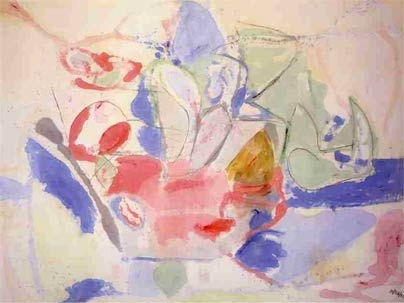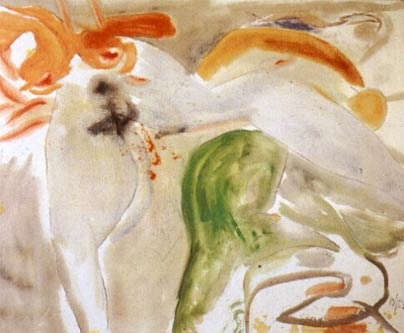An MIT art historian's new research in art criticism suggests that abstract expressionist painter Helen Frankenthaler, one of America's most famous female artists, skillfully produced large-scale, sought-after works that not only conformed to the rules of abstraction but also contained clear, sensual elements of rebellion against them.
According to Caroline Jones, associate professor of art history, Frankenthaler's painterly signs of protest lasted barely 10 years - not long, by the standard of her remarkably stable, five-decade career - but their visible presence in her 1950s canvases presaged feminist performance artists such as Yoko Ono and Carolee Schneemann working in the 1960s and 1970s.
Jones presented a talk, "Helen Frankenthaler and Clement Greenberg: The Painter, the Critic, her Pictures, his Words," sponsored by MIT's Program in Women's Studies, on Nov. 19 in Room 14E-304.
In her discussion of Frankenthaler's work, Jones noted how figurative elements-distinct references to female bodies, whole or in part, and to female and male sexuality-are all hidden in plain sight in the artist's early paintings.
Jones used slides to contrast Frankenthaler's paintings that conformed fully to abstraction, such as "Mountains and Sea" (1952), with those that did not, including "Scene with Nude" (1952), "Two Live As One on a Crocodile Isle" (1959), and "Arcadia" (1962), a 7-foot-high painting that contains a "Rorschach-type image that can be read as a coded nude," said Jones.
Fitting into the 'Greenbergian universe'
The art-historical question is: how could these clear signs go un-remarked and unresearched? "How can certain objects of art be in view and remain invisible? " Jones asked at the outset of her hour-long presentation.
For Jones, currently editing galleys of her new book, "Eyesight Alone: Clement Greenberg's Modernism and the Bureaucratization of the Senses," the answer lies partly in the relationship between Frankenthaler, 76, and Clement Greenberg (1909-1994), an art critic and cultural mega-star whose presence defined the 1950s and 1960s art world. In postwar America, if a work didn't fit in the "Greenbergian universe," it was not seen as art.
Frankenthaler was an intimate of Greenberg's during the 1950s, Jones noted, yet he never reviewed her paintings in print (he wrote for Partisan Review and The Nation). Never mind that "Mountains and Sea" blew the metaphorical socks off painters Kenneth Noland and Morris Louis when they visited Frankenthaler's studio. That breakthrough painting just relegated her to the role of "distant matriarch," said Jones. The Greenbergian regime was all male.
Yet there's that nagging question, said Jones: Were the more subversive elements of Frankenthaler's work visible to the feminist avant-garde then emerging in New York?
"Does a work have to occur as text before it is visible?" Jones asked. In a commentary-mad culture, what happens to the un-commented?
Jones acknowledged that Frankenthaler was in a good position to find out. An affluent, highly cultured New Yorker, she had no need to get a day job to support her painting career. Her mainstream, "Greenbergian" works were always successful. Eventually, their steady loveliness straddled the art market's "contradictory imperatives of absolute originality and a repeatable signature style," said Jones. Now her signature stain paintings hang in major museums and sell for six figures at auction.
Cautioning against feminist interpretations
Jones cautioned her lunch-hour audience not to attribute feminist politics to Frankenthaler herself, despite the evidence of figurative elements in her early work. The artist herself had no fringy, feminist intentions, no matter what later work she may have inspired, Jones said.
"Frankenthaler closed herself off from those sensibilities. After 1967, she stopped doing paintings like 'Arcadia.' She had to choose a strategy: either enter the patriarchy and deal with its rules or engage with the female body and all of its issues and enter the avant-garde," Jones said.
Jones noted during the question and answer session following her talk that "Frankenthaler's bargain" was a choice as "old as culture itself." Jones said she hopes to provoke an "empathetic understanding of Frankenthaler's bargain by situating a study of the artist in a book about the most powerful critic of the twentieth century."
A version of this article appeared in MIT Tech Talk on December 8, 2004 (download PDF).








